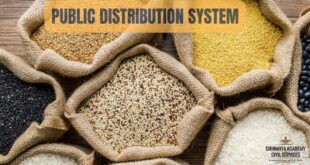- India has a long history of producing agricultural commodities, and has been a hub for the global spices, tea, and coffee trade for several centuries.
- Its scale and diversity have gone from strength to strength over the last three decades, such that the share of high-value agricultural commodities in the total GDP of the agricultural sector has significantly expanded.
- The growth has coincided with the rise of narratives and initiatives focused on ensuring sustainability in the commodity value chains.
- This is an acknowledgment of this sector’s contribution to environmental degradation, including through carbon emissions across the whole supply chain and the injudicious use of water and chemicals, which also threaten the long-term viability of production.
- There now exist reliable estimates of the emissions per unit of production for several commodities in different production systems.
Commodity crops
- From a global sustainability viewpoint, agricultural commodities are often defined based on the level of their orientation towards international demand and supply in the form of exports.
- Here, commodity crops are those “primarily grown to be sold on international markets” (source).
- In this framing there are a few key commodities of global significance, like soybean, cocoa, coffee, tea, rubber, palm oil, and cotton. They are critically related to global sustainability challenges and currently drive significant environmental and climatic risks, including deforestation, biodiversity loss, freshwater depletion, and soil degradation.
- India, as one of the anchors of global agricultural commodity trade both as major consumer and producer, needs to expand this understanding to include commodities that are actively imported, such as oilseeds; whose production is both for domestic and international markets (fruits and vegetables); and which get significant attention within the policy and action spaces (rice and cotton).
- Interventions in the production, trade and consumption of these commodities is likely to drive transformational impacts on environmental sustainability across the sector.
Challenges to sustainability?
- Against this background, ensuring that an agricultural commodity value chain is environmentally sustainable is a multi-dimensional challenge. Four dimensions in particular vex efforts to mitigate its environmental impact while benefiting farmers, processors, retailers, etc.
- First, market and producer characteristics determine where responsible and effective practices can be implemented to have the greatest impact. Nudges for commodities oriented towards foreign markets may often be determined by India’s export policies or consumer preferences and regulations of sourcing destinations.
- For example, the expansion of cold-storage facilities to make export-oriented commodities more competitive in global markets is expected to increase energy demand. Estimating how this energy need will be met – through fossil fuels or renewables – is likely to determine the emissions associated with that commodity.
- In contrast, evolving robust policies on production, processing, and retail could help enforce changes for the relatively price-sensitive and brand-agnostic Indian consumer.
- It is also important to consider producer attributes. For commodity production led by agri-businesses, especially those with a global footprint, sector-wide sustainability commitments and standards can drive the adoption of practices on the ground. Domestic efforts, in these cases, would be well-placed to focus on holding these organisations accountable and ensuring these commitments are being met on the ground.
- In the case of smallholders, effective and low-cost certification could be one way to improve practices throughout the value chain, simultaneously mitigating the environmental impact and delivering price premiums to producers. This can be supplemented by coordinated policy action to raise the floor to a minimum set of production, sourcing, and retailing standards and practices.
- Second, the nature of production significantly determines the nature of intervention. Commodity production may be in intensive or extensive agricultural systems, or in the case of some commodities like tea or rubber, in agroforestry systems. In these cases, whether we adopt better land-use strategies is determined by the nature of the production process, including the type of field preparation, the quality of seeds, and the amount and nature of inputs.
- Regionally, some efforts have led to climate, biodiversity, and livelihood benefits while helping preserve our ecological heritage in production landscapes. For example, evidence suggests that the introduction of biodiversity-friendly coffee in Karnataka has mitigated human-animal conflicts in the region to a significant extent. Similarly, the public attention on millets, through the declaration of the ‘International Year of Millets’, has helped widen demand across Indian and international consumers.
- Third, strong governance mechanisms and policies support value chains, either by providing subsidies, market access, and infrastructural support in terms of extension, processing, and storage facilities – or by a combination of several such aspects. Repurposing such support to improve production, sourcing, and consumption by targeting healthy and natural solutions can help have transformational impacts in commodity value chains.
- For example, to incentivise agri-businesses to report on and reduce the environmental consequences of their supply chain, targeted regulation may prove useful. Some of these initiatives are currently operational already.
- To wit, national guidelines on responsible business urge organisations to encourage and support their suppliers, distributors, partners, and other stakeholders to adopt sustainable practices.
- Fourth, no initiative to mitigate the environmental effects of agricultural value chains can be complete without benefiting the large number of people that depend on these value chains for sustenance. Issues with working conditions and labour rights are depressingly common in commodity value chains in India. Even when it comes to enacting policies and regulations or sustainability commitments on the ground, the burden of responsibility to change practices typically falls on those who are most marginalised, and thus have the least agency to shape initiatives or direct actions.
- The success of any environmental sustainability initiative hinges on getting actors like them onboard and providing them with adequate safety nets – while also accounting for the climate crisis’s effects on production. These safety nets could take the form of rewarding compliance, committing to support farm-level flexibility, and evolving robust insurance mechanisms.
- These four dimensions are what make mitigating environmental impacts in agricultural commodity value chains so difficult to achieve in practice. But they also present opportunities.
- There are ways through which concerted and coordinated action can have a positive impact on commodity value chains. If such actions are combined with the right kind of support systems while keeping equity and justice in mind, agricultural commodity value chains can deliver for India’s people and its environment.
SOURCE: THE HINDU, THE ECONOMIC TIMES, PIB
 Chinmaya IAS Academy – Current Affairs Chinmaya IAS Academy – Current Affairs
Chinmaya IAS Academy – Current Affairs Chinmaya IAS Academy – Current Affairs


